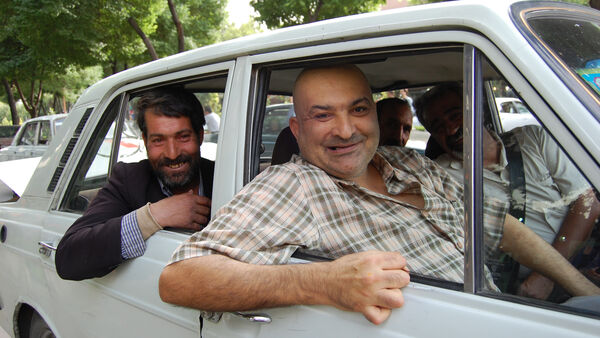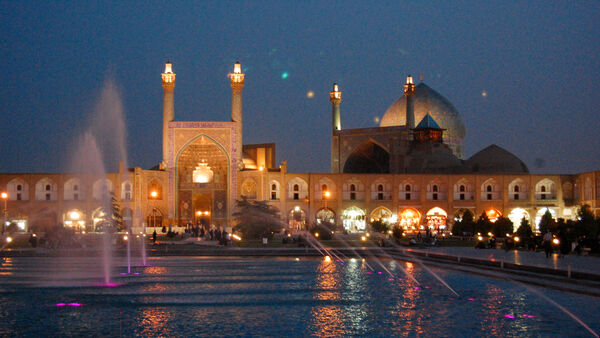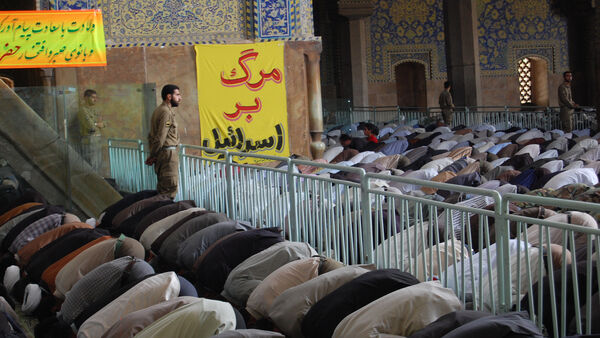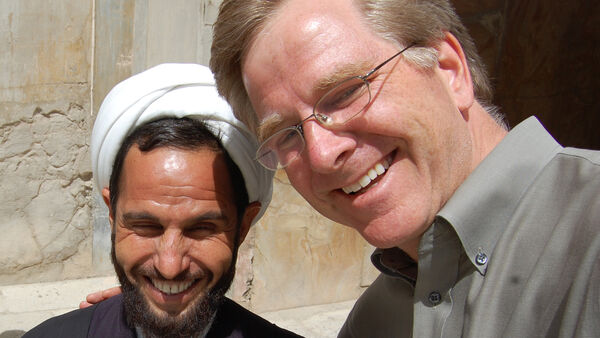Iran Travel Journal (part 4)





Death to…Whatever!
Traffic is notorious in Tehran. Drivers may seem crazy, but I was impressed by their expertise at keeping things moving. At major intersections, there are no lights — everyone just shuffles through. People are great drivers, and, somehow, it works. I think I'll actually drive more aggressively when I get home.
While the traffic is hair-raising, it's not noisy. Because of a history of motorcycle bandits and assassinations, only small (and therefore quieter) motorcycles are allowed. To get somewhere in a hurry, motorcycle taxis are a blessing. While most Iranians ignore helmet laws, I'm more cautious — I'd rather leave a little paint on passing buses than a piece of scalp.
Adding to the chaotic traffic mix are pedestrians, doing their best to navigate a wild landscape. Locals joke that when you set out to cross a big street, you "go to Chechnya." I'm told that Iran loses more than 30,000 people on the roads each year (in cars and on foot).
While in Tehran, we're being zipped smoothly around by Majid, our driver. Majid navigates our eight-seater bus like a motor scooter, weaving in and out of traffic that flows down the street and between lanes like rocks in a landslide. To illustrate how clueless I am here, for three days I've been calling him "Najaf." And whenever a bit of filming goes well and we triumphantly return to the car, I give him an enthusiastic thumbs-up. But today, Majid patiently explained that I've been confusing his name with a city in Iraq...and that giving someone a thumbs-up in Iran is like giving them the finger.
While traffic is enough to make you scream, people are incredibly good-humored on the road. I never heard angry horns honking. While stalled in a Tehran jam, people in the neighboring car see me sitting patiently in the back of our van: a foreigner stuck in their traffic. They roll down their window and hand Majid a bouquet of flowers with instructions to give it to the visitor. When the traffic jam breaks up, we move on — with a bouquet from strangers on my lap.
Later, as we struggle to drive along a horribly congested street, Majid declares, "Death to traffic." Then he says, "Because we can do nothing about this traffic, this is what we do. We can all say, 'Death to traffic.'"
The casual tone of Majid's telling aside made me think differently about one of the biggest gripes many Americans have about Iranians: Their penchant for declaring "Death to" this and that. Does Majid literally want to kill all those drivers that were in our way?
The experience makes me wonder if Iranians' "Death to" curses are not so different from Westerners who exclaim, "Damn those French" or "Damn those teenagers" or "Damn this traffic jam." Even though this technically means "die and burn in hell"…of course we don't mean it so severely. (The same goes for some English-speakers' liberal use of the "f-word," which is also rarely intended literally.)
Don't get me wrong: All those "Death to America" and "Death to Israel" murals are impossible to justify. (Can you imagine Americans tolerating "Bomb Iran" banners in their towns?) But I will say they seemed very incongruous with the people I met. Do the Iranians literally wish "death" to the US and Israel? Or is it a mix of international road rage, fear, frustration — and the seductive clarity of a catchy slogan?
Friday: Let Us Pray
Esfahan, Iran's "second city" with 3.5 million people, is a showcase of ancient Persian splendor. One of the finest cities in Islam, and famous for its dazzling blue-tiled domes and romantic bridges, the city is also just plain enjoyable. I'm not surprised that in Iran, this is the number-one honeymoon destination.
Everything in Esfahan seems to radiate from the grand Imam Square, dominated by the Imam Mosque — one of holiest in Iran. Dating from the early 1600s, its towering facade is as striking as the grandest cathedrals of Europe.
We were in Iran for just one Friday, the Muslim "Sabbath." Fortunately, we were in Esfahan, so we could attend (and film) a prayer service at this colossal house of worship.
Filming in a mosque filled with thousands of worshippers required permission. Explaining our needs with administrators there, it hit me that the Islamic Revolution employs similar strategies to a communist takeover: Both maintain power by installing partisans in key positions. But the ideology Iran is protecting is not economic (as in the USSR), but religious.
President Mahmoud Ahmadinejad has inspired a fashion trend in Iran: simple dark suit, white shirt, no tie, light black beard. Reminiscent of apparatchniks in Soviet times, all of the mosque administrators dressed the part and looked like the president.
To film the service — which was already well underway — we were escorted in front of 5,000 people praying. When we had visited this huge mosque the day before, all I had seen was a lifeless shell with fine tiles for tourists to photograph. An old man had stood in the center of the floor and demonstrated the haunting echoes created by the perfect construction. Old carpets had been rolled up and strewn about like dusty cars in a haphazard parking lot. Today the carpets were rolled out, cozy, and lined with worshippers.
I felt self-conscious, a tall pale American tiptoeing gingerly over the little tablets Shia Muslim men place their heads on when they bend down to pray. Planting our tripod in the corner, we observed.
As my brain wandered (just like it sometimes does at home when listening to a sermon), I felt all those worshippers were looking at me rather than listening to their cleric speaking. Soldiers were posted throughout the mosque, standing like statues in their desert-colored fatigues. When the congregation stood, I didn't notice them, but when all bowed, the soldiers remained standing — a reminder that the world was dangerous...especially in mosques. I asked our guide, Seyed, to translate a brightly painted banner above the worshippers. He answered, "Death to Israel."
Despite this disturbing detail, I closed my eyes and let the smell of socks remind me of mosques I'd visited in other Muslim countries. I pulled out my little Mecca compass, the only souvenir I've purchased so far. Sure enough, everyone was facing exactly the right way.
Watching all the worshippers bow and stand, and pray in unison, at first seemed threatening to me. Then I caught the eye of a worshipper having a tough time focusing. He winked. Another man's cell phone rang. He answered in a frustrated whisper as if saying, "Dang, I should have turned that thing off." The mosaics above — Turkish blue and darker Persian blue — added a harmony and calmness to the atmosphere.
I made a point to view the service as if it were my own church, just north of Seattle. I was struck by the similarities: the too-long sermon, the "passing of the peace" (when everyone greets the people around them), the convivial atmosphere as people line up to shake the hand of the cleric after the service, and the fellowship as everyone hangs out in the courtyard afterwards. On our way out, I shook the hand of the young cleric — he had a short slight build, a tight white turban, a trim Ahmadinejad-style beard, big teeth, and a playful smile. In the courtyard, a man hit the branches of a mulberry tree with a pole as kids scrambled for the treasured little berries.
Esfahan TV, which had televised the prayer service, saw us and wanted an interview. It was exciting to be on local TV. They asked why we were here, how I saw Iranian people, and why I thought there was a problem between the US and Iran (I pointed out the "Death to Israel" banner for starters). They fixated on whether our show would actually air...and if we'd spin our report to make Iran look evil.
Leaving the mosque, our crew pondered how easily the footage we'd just shot could be cut and edited to appear either menacing or heartwarming, depending on our agenda. Our mosque shots could be juxtaposed with guerillas leaping over barbed wire and accompanied by jihadist music to be frightening. Instead, we planned to edit it to match our actual experience: showing the guards and "Death to Israel" banner, but focusing on the men with warm faces praying with their sons at their sides, and the children outside scrambling for mulberries.
It occurred to me that the segregation of the sexes — men in the center and women behind a giant hanging carpet at the side — contributes to the negative image many Western Christians have of Islam. Then, playing the old anthropologist's game of changing my perspective, I considered how the predominantly male-led Christian services that I'm so comfortable with could also be edited to look ominous to those unfamiliar with the rituals. At important Roman Catholic Masses, you'll see a dozen priests — all male — in robes before a bowing audience. The leader of a billion Catholics is chosen by a secretive, ritual-filled gathering of old men in strange hats and robes with chanting and incense. It could be filled with majesty, or with menace…depending on what you show and how you show it.
We set up to film across the vast square from the mosque. My lines were memorized and I was ready to go. Then, suddenly, the cleric with the beaming smile came toward us with a platter of desserts — the local ice cream specialty, like frozen shredded wheat sprinkled with coconut. I felt like Rafsanjani (he looked to me like Iran's moderate former president) had just interrupted my work to serve us ice cream. We had a lively conversation, joking about how it might help if his president went to my town for a prayer service, and my president came here.

